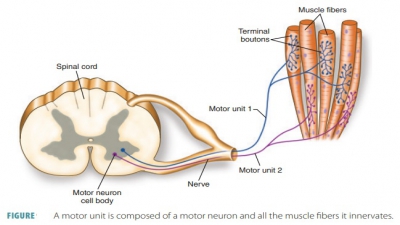Energy Sources for Contraction
| Home | | Anatomy and Physiology | | Anatomy and Physiology Health Education (APHE) |Chapter: Anatomy and Physiology for Health Professionals: Support and Movement: Muscle Tissue
Muscle fibers have just enough energy (ATP) for short-term contraction. ATP must be regenerated when fibers are active, using existing ATP molecules in the cells.
Energy
Sources for Contraction
Muscle fibers have just enough
energy (ATP) for short-term contraction. ATP must be regenerated when fibers
are active, using existing ATP molecules in the cells. ATP is regenerated from
ADP and phos-phate. Creatine
phosphate accomplishes this with
high-energy phosphate bonds. It is between four and six times more abundant in
muscle fibers than ATP; however, it does not directly supply energy. It stores
excess energy from the mitochondria in the phosphate bonds. Therefore, muscle
cells store more creatine phosphate than ATP. Excitation-contraction coupling
requires both ATP and calcium ions.
When ATP breaks down, energy from
creatine phosphate is transferred to ADP molecules to con-vert them back into
ATP. Creatine phosphate stores are exhausted rapidly when muscles are active;
there-fore, the muscles use cellular respiration of glucose as energy to
synthesize ATP. Energy stored in creatine phosphate is eventually used to
recharge ADP and convert it back to ATP. The enzyme that causes this conversion
is creatine kinase. Muscle damage
causes creatine kinase to leak across plasma membranes into the bloodstream.
High blood levels of creatine kinase usually mean that serious muscle damage
has occurred.
Nearly all (95%) of the ATP
demands of a resting cell are provided by aerobic
metabolism. This involves the absorption of oxygen, ADP, phosphate ions,
and organic substrates such as pyruvate from the sur-rounding cytoplasm by the
mitochondria. These mol-ecules then enter the citric acid cycle. Resting skeletal muscle fibers rely almost
totally on aerobic metabo-lism of fatty acids absorbed from the circulation to
generate ATP.
Oxygen Use and Debt
Oxygen is required for the
breakdown of glucose in the mitochondria. Red blood cells carry oxygen, bound
to hemoglobin molecules. Hemoglobin is the pigment that makes blood
appear red. The pigment myoglobin is
synthesized in the muscles to give skeletal muscles their reddish-brown color.
Myoglobin can also com-bine with oxygen and temporarily store it to reduce
muscular requirements for continuous blood supply during contraction.
When skeletal muscles are used
for a minute or more, anaerobic
respiration is required for energy. In one
type of anaerobic respiration, glucose is broken down via glycolysis to yield pyruvic acid, which reacts by producing lactic acid. Lactic
acid can accumulate in muscles but diffuses in the bloodstream, reaching the
liver, where it is synthesized into glucose. This acid is a three-carbon
molecule, which dissociates into one hydrogen ion and one negatively charged lactate ion. The movement of lactate to
the liver and glucose back to muscle
cells is called the Cori cycle.
When exercising strenuously,
oxygen is used mostly to synthesize ATP. As lactic acid increases, an oxygen debt
develops, also referred to as excess postexercise oxygen consumption. Oxygen
debt is equivalent to the amount of
oxygen that liver cells require to convert the lactic acid into glucose and the
amount needed by muscle cells to restore ATP and creatine phosphate levels.
Endurance is defined as the amount of time
during which a particular muscular
activity can be performed without fatigue. Anaerobic
endurance is the amount of time
contraction of muscles can continue to be supported by glycolysis and the
reserves of ATP and creatine phosphate. Aerobic
endurance is the amount of time muscle contraction can continue while being
supported by the activities of the mitochondria. Anaerobic endurance promotes
hypertrophy, whereas aerobic endurance does not.
It may take several hours for the
body to convert lactic acid back into glucose. Muscles may experience a change
in their metabolic activity as exercise levels change. Increased exercise
raises the muscles’ capacity for glycolysis. Aerobic exercise increases the
muscles’ capacity for aerobic respiration. This is summarized in TABLE 9-3. For
optimal health, you should alternate between aerobic and anaerobic exercise.

Muscle Fatigue
Prolonged exercise may cause a
muscle to become unable to contract. This condition is called muscle fatigue, and it may also occur because of interruption of muscular blood
supply or occasionally a lack of ACh in the motor neuron axons. Lactic acid
accumulation is the usual cause of muscular fatigue. As lactic acid lowers pH
levels, muscle fibers cannot respond to stim-ulation. When a muscle becomes fatigued
and cramps, it experiences a sustained, involuntary contraction. Although not
fully understood, muscle cramps appear to be caused by changes in the
extracellular fluid sur-rounding muscle fibers and motor neurons.
In a muscle’s recovery period, conditions return to
the normal levels present before the exertion occurred. After moderate
activity, muscle fibers may need several hours to completely recover.
Sustained, higher level activity may require as much as one week for recovery.
Production of Heat
Most of the energy released in
cellular respiration becomes heat. Muscle tissue generates a lot of heat
because muscles form much of the total body mass. Body temperature is partially
maintained by the blood transporting heat generated by the muscle to other body
tissues. Heat energy produced from muscle con-traction is released through the
integumentary system.

